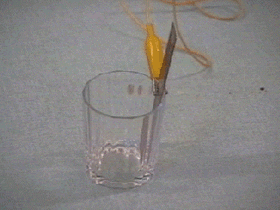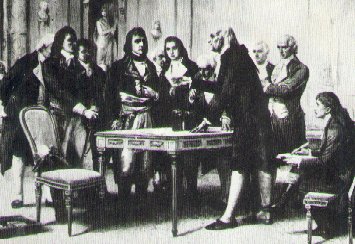

Volta presents the pile to Napoleon
The animation shows how by placing a strip of copper and one of zinc in a weak sulphuric acid solution can to provide a flow of electrons. An outside circuit must be added. Part of the acid combines with zinc and gives up electrons. This gives the zinc an excess of electrons, or a negative charge. Soon the zinc gets enough electrons and repels the entry of any more. This stops the acid action on the zinc.
Meanwhile the acid solution has also taken electrons from the copper to make up for those given up to the zinc. Thus the copper, by loosing electrons, gets a positive charge. When back pressure stops the action, the + charge on the copper and the - charge on the zinc are ready to drive electrons around any pathway that opens up from the zinc back to the copper.(1)
Volta to build the first pile tried placing unlike metals in piles between pads moistened with acid or salt solution. The pile produced a steady direct current.
Volta informed Sir Joseph Banks, president of the Royal Society, in mars 1800. The pile brought a revolutionary change in the studies of electricity because experimenters were handicapped by the fact the charges they studied discharge almost instantly. The currrent produced by the first pile had a duration of some hours.
Sir Humphry Davy invented in 1801 the carbon-arc lamp, the beginning of electric lighting.
The first attempt to introduce the electric lighting on a large scale was that of 1845. This attempt had failed because the current obtained by the piles was too expensive.
(1)This description is based on the modern theory that says the electrons flow from - to + in the circuit. Electricians, however, generally use the "Franklin rule" which holds that current flows from + to -. Scientists often call the "Franklin flow" a conventional current, and they remember that in the circuit the electrons flow the other way. It is only within the cell that the electrons flow from + to -.